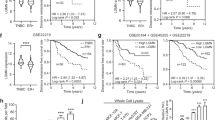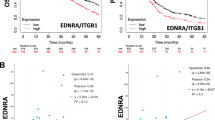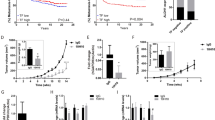Abstract
Specific cleavage of the transmembrane molecule, CUB domain-containing protein-1 (CDCP1), by plasmin-like serine proteases induces outside–in signal transduction that facilitates early stages of spontaneous metastasis leading to tumor cell intravasation, namely cell escape from the primary tumor, stromal invasion and transendothelial migration. We identified active β1 integrin as a biochemical and functional partner of the membrane-retained 70-kDa CDCP1 fragment, newly generated from its full-length 135-kDa precursor though proteolytic cleavage by serine proteases. Both in cell cultures and in live animals, active β1 integrin complexed preferentially with functionally activated, phosphorylated 70-kDa CDCP1. Complexing of β1 integrin the 70-kDa with CDCP1 fragment induced intracellular phosphorylation signaling, involving focal adhesion kinase-1 (FAK) and PI3 kinase (PI3K)-dependent Akt activation. Thus, inhibition of FAK/PI3K activities by specific inhibitors as well as short-hairpin RNA downregulation of β1 integrin significantly reduced FAK/Akt phosphorylation under conditions where CDCP1 was processed by serine proteases, indicating that FAK/PI3K/Akt pathway operates downstream of cleaved CDCP1 complexed with β1 integrin. Furthermore, this complex-dependent signaling correlated positively with high levels of tumor cell intravasation and dissemination. Correspondingly, abrogation in vivo of CDCP1 cleavage either by unique cleavage-blocking monoclonal antibody 10-D7 or by inhibition of proteolytic activity of plasmin-like serine proteases with aprotinin prevented β1 integrin/CDCP1 complexing and downstream FAK/Akt signaling concomitant with significant reduction of stromal invasion and spontaneous metastasis. Therefore, β1 integrin appears to serve as a motility-regulating partner mediating cross-talk between proteolytically cleaved, membrane-retained CDCP1 and members of FAK/PI3K/Akt pathway. This CDCP1 cleavage-induced signaling cascade constitutes a unique mechanism, independent of extracellular matrix remodeling, whereby a proteolytically cleaved CDCP1 regulates in vivo locomotion and metastasis of tumor cells through β1 integrin partnering. Our findings indicate that CDCP1 cleavage, occurring at the apex of a β1 integrin/FAK/PI3K/Akt signaling cascade, may represent a therapeutic target for CDCP1-positive cancers.
This is a preview of subscription content, access via your institution
Access options
Subscribe to this journal
Receive 50 print issues and online access
$259.00 per year
only $5.18 per issue
Buy this article
- Purchase on Springer Link
- Instant access to full article PDF
Prices may be subject to local taxes which are calculated during checkout








Similar content being viewed by others
References
Scherl-Mostageer M, Sommergruber W, Abseher R, Hauptmann R, Ambros P, Schweifer N . Identification of a novel gene, CDCP1, overexpressed in human colorectal cancer. Oncogene 2001; 20: 4402–4408.
Perry SE, Robinson P, Melcher A, Quirke P, Buhring HJ, Cook GP et al. Expression of the CUB domain containing protein 1 (CDCP1) gene in colorectal tumour cells. FEBS Lett 2007; 581: 1137–1142.
Uekita T, Tanaka M, Takigahira M, Miyazawa Y, Nakanishi Y, Kanai Y et al. CUB-domain-containing protein 1 regulates peritoneal dissemination of gastric scirrhous carcinoma. Am J Pathol 2008; 172: 1729–1739.
Wong CH, Baehner FL, Spassov DS, Ahuja D, Wang D, Hann B et al. Phosphorylation of the SRC epithelial substrate trask is tightly regulated in normal epithelia but widespread in many human epithelial cancers. Clin Cancer Res 2009; 15: 2311–2322.
Miyazawa Y, Uekita T, Hiraoka N, Fujii S, Kosuge T, Kanai Y et al. CUB domain-containing protein 1, a prognostic factor for human pancreatic cancers, promotes cell migration and extracellular matrix degradation. Cancer Res 2010; 70: 5136–5146.
Ikeda J, Oda T, Inoue M, Uekita T, Sakai R, Okumura M et al. Expression of CUB domain containing protein (CDCP1) is correlated with prognosis and survival of patients with adenocarcinoma of lung. Cancer Sci 2009; 100: 429–433.
Awakura Y, Nakamura E, Takahashi T, Kotani H, Mikami Y, Kadowaki T et al. Microarray-based identification of CUB-domain containing protein 1 as a potential prognostic marker in conventional renal cell carcinoma. J Cancer Res Clin Oncol 2008; 134: 1363–1369.
Razorenova OV, Finger EC, Colavitti R, Chernikova SB, Boiko AD, Chan CK et al. VHL loss in renal cell carcinoma leads to up-regulation of CUB domain-containing protein 1 to stimulate PKCdelta-driven migration. Proc Natl Acad Sci USA 2011; 108: 1931–1936.
Siva AC, Wild MA, Kirkland RE, Nolan MJ, Lin B, Maruyama T et al. Targeting CUB domain-containing protein 1 with a monoclonal antibody inhibits metastasis in a prostate cancer model. Cancer Res 2008; 68: 3759–3766.
Hooper JD, Zijlstra A, Aimes RT, Liang H, Claassen GF, Tarin D et al. Subtractive immunization using highly metastatic human tumor cells identifies SIMA135/CDCP1, a 135 kDa cell surface phosphorylated glycoprotein antigen. Oncogene 2003; 22: 1783–1794.
Yang L, Nyalwidhe JO, Guo S, Drake RR, Semmes OJ . Targeted identification of metastasis-associated cell-surface sialoglycoproteins in prostate cancer. Mol Cell Proteomics 2011; 10: M110.007294.
Rikova K, Guo A, Zeng Q, Possemato A, Yu J, Haack H et al. Global survey of phosphotyrosine signaling identifies oncogenic kinases in lung cancer. Cell 2007; 131: 1190–1203.
Leroy C, Fialin C, Sirvent A, Simon V, Urbach S, Poncet J et al. Quantitative phosphoproteomics reveals a cluster of tyrosine kinases that mediates SRC invasive activity in advanced colon carcinoma cells. Cancer Res 2009; 69: 2279–2286.
Liu H, Ong SE, Badu-Nkansah K, Schindler J, White FM, Hynes RO . CUB-domain-containing protein 1 (CDCP1) activates Src to promote melanoma metastasis. Proc Natl Acad Sci USA 2011; 108: 1379–1384.
Benes CH, Wu N, Elia AE, Dharia T, Cantley LC, Soltoff SP . The C2 domain of PKCdelta is a phosphotyrosine binding domain. Cell 2005; 121: 271–280.
Uekita T, Jia L, Narisawa-Saito M, Yokota J, Kiyono T, Sakai R . CUB domain-containing protein 1 is a novel regulator of anoikis resistance in lung adenocarcinoma. Mol Cell Biol 2007; 27: 7649–7660.
Alvares SM, Dunn CA, Brown TA, Wayner EE, Carter WG . The role of membrane microdomains in transmembrane signaling through the epithelial glycoprotein Gp140/CDCP1. Biochim Biophys Acta 2008; 1780: 486–496.
He Y, Wortmann A, Burke LJ, Reid JC, Adams MN, Abdul-Jabbar I et al. Proteolysis-induced N-terminal ectodomain shedding of the integral membrane glycoprotein CUB domain-containing protein 1 (CDCP1) is accompanied by tyrosine phosphorylation of its C-terminal domain and recruitment of Src and PKCdelta. J Biol Chem 2010; 285: 26162–26173.
Benes CH, Poulogiannis G, Cantley LC, Soltoff SP . The SRC-associated protein CUB domain-containing protein-1 regulates adhesion and motility. Oncogene 2012; 31: 653–663.
Casar B, He Y, Iconomou M, Hooper JD, Quigley JP, Deryugina EI . Blocking of CDCP1 cleavage in vivo prevents Akt-dependent survival and inhibits metastatic colonization through PARP1-mediated apoptosis of cancer cells. Oncogene 2012; 31: 3924–3938.
Deryugina EI, Conn EM, Wortmann A, Partridge JJ, Kupriyanova TA, Ardi VC et al. Functional role of cell surface CUB domain-containing protein 1 in tumor cell dissemination. Mol Cancer Res 2009; 7: 1197–1211.
Bekes EM, Deryugina EI, Kupriyanova TA, Zajac E, Botkjaer KA, Andreasen P et al. Activation of pro-uPA is critical for initial escape from the primary tumor and hematogenous dieesmination of human carcinoma cells. Neoplasia 2011; 13: 806–821.
Luque A, Gomez M, Puzon W, Takada Y, Sanchez-Madrid F, Cabanas C . Activated conformations of very late activation integrins detected by a group of antibodies (HUTS) specific for a novel regulatory region (355-425) of the common beta 1 chain. J Biol Chem 1996; 271: 11067–11075.
Bekes EM, Deryugina EI, Kupriyanova TA, Zajac E, Botkjaer KA, Andreasen PA et al. Activation of pro-uPA is critical for initial escape from the primary tumor and hematogenous dissemination of human carcinoma cells. Neoplasia 2011; 13: 806–821.
Bhatt AS, Erdjument-Bromage H, Tempst P, Craik CS, Moasser MM . Adhesion signaling by a novel mitotic substrate of src kinases. Oncogene 2005; 24: 5333–5343.
Deryugina EI, Quigley JP . Cell surface remodeling by plasmin: a new function for an old enzyme. J Biomed Biotechnol 2012; 2012: 564529.
Spassov DS, Wong CH, Sergina N, Ahuja D, Fried M, Sheppard D et al. Phosphorylation of Trask by Src kinases inhibits integrin clustering and functions in exclusion with focal adhesion signaling. Mol Cell Biol 2011; 31: 766–782.
Wortmann A, He Y, Christensen ME, Linn M, Lumley JW, Pollock PM et al. Cellular settings mediating Src substrate switching between focal adhesion kinase tyrosine 861 and CUB-domain-containing protein 1 (CDCP1) tyrosine 734. J Biol Chem 2011; 286: 42303–42315.
Shattil SJ, Kim C, Ginsberg MH . The final steps of integrin activation: the end game. Nat Rev Mol Cell Biol 2010; 11: 288–300.
Desgrosellier JS, Cheresh DA . Integrins in cancer: biological implications and therapeutic opportunities. Nat Rev Cancer 2010; 10: 9–22.
Brown TA, Yang TM, Zaitsevskaia T, Xia Y, Dunn CA, Sigle RO et al. Adhesion or plasmin regulates tyrosine phosphorylation of a novel membrane glycoprotein p80/gp140/CUB domain-containing protein 1 in epithelia. J Biol Chem 2004; 279: 14772–14783.
Pylayeva Y, Gillen KM, Gerald W, Beggs HE, Reichardt LF, Giancotti FG . Ras- and PI3K-dependent breast tumorigenesis in mice and humans requires focal adhesion kinase signaling. J Clin Invest 2009; 119: 252–266.
Zhao J, Guan JL . Signal transduction by focal adhesion kinase in cancer. Cancer Metastasis Rev 2009; 28: 35–49.
Zhao X, Guan JL . Focal adhesion kinase and its signaling pathways in cell migration and angiogenesis. Adv Drug Deliv Rev 2011; 63: 610–615.
Deryugina EI, Zijlstra A, Partridge JJ, Kupriyanova TA, Madsen MA, Papagiannakopoulos T et al. Unexpected effect of matrix metalloproteinase down-regulation on vascular intravasation and metastasis of human fibrosarcoma cells selected in vivo for high rates of dissemination. Cancer Res 2005; 65: 10959–10969.
Conn EM, Botkjaer KA, Kupriyanova TA, Andreasen PA, Deryugina EI, Quigley JP . Comparative analysis of metastasis variants derived from human prostate carcinoma cells. Roles in intravasation of VEGF-mediated angiogenesis and uPA-mediated invasion. Am J Pathol 2009; 175: 1638–1652.
Acknowledgements
This study was supported by NIH grants R01 CA 129484 and R01 CA 105412 (to JPQ), NIH/NCRR/STSI Grant RR 025774 (Pilot Award to EID), Postdoctoral Fellowship from the Science and Innovation Ministry of Spain (to BC), Research Fellowships from Nachwuchsförderungskredit/Stiefel-Zangger Foundation, University of Zurich (to IR), and NIH grants HL56595 and HL57900 (to SJS).
Author information
Authors and Affiliations
Corresponding authors
Ethics declarations
Competing interests
The authors declare no conflict of interest.
Additional information
Supplementary Information accompanies the paper on the Oncogene website
Supplementary information
Rights and permissions
About this article
Cite this article
Casar, B., Rimann, I., Kato, H. et al. In vivo cleaved CDCP1 promotes early tumor dissemination via complexing with activated β1 integrin and induction of FAK/PI3K/Akt motility signaling. Oncogene 33, 255–268 (2014). https://doi.org/10.1038/onc.2012.547
Received:
Revised:
Accepted:
Published:
Issue Date:
DOI: https://doi.org/10.1038/onc.2012.547
Keywords
This article is cited by
-
CDCP1 expression is frequently increased in aggressive urothelial carcinoma and promotes urothelial tumor progression
Scientific Reports (2023)
-
Molecular mechanism by which CDCP1 promotes proneural-mesenchymal transformation in primary glioblastoma
Cancer Cell International (2022)
-
Targeting CDCP1 gene transcription coactivated by BRD4 and CBP/p300 in castration-resistant prostate cancer
Oncogene (2022)
-
Substrate-biased activity-based probes identify proteases that cleave receptor CDCP1
Nature Chemical Biology (2021)
-
Identification of CD318 (CDCP1) as novel prognostic marker in AML
Annals of Hematology (2020)



